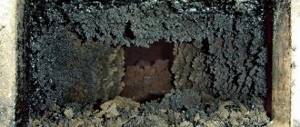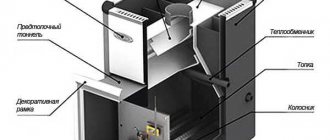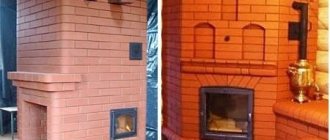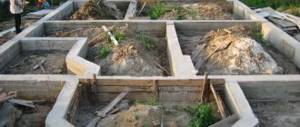A lot of home craftsmen make their own sauna stoves. However, not only for the bath. In order for the stove to have an attractive appearance, it is advisable to paint it. Since paint not only improves appearance, but also protects the metal surface from splashes and reduces surface contact with oxygen, oxidation occurs more slowly.
Brick stoves are less often painted, especially when they are made of good brick. But in some cases, the brick begins to crumble - it has overheated or was unlucky with the batch. Cracks also often appear in the masonry. They are sealed with mortar, but in order to give a more presentable appearance, they are painted. For all these needs, high-temperature paint is required.
Rogneda Pyrex - fire-retardant paint for wood at an affordable price
Rogneda Pyrex is a fireproof fireproof (fireproof) paint for wood, which makes the material fire-resistant. The product is environmentally friendly, it can be purchased for painting interior ceilings and walls, facades, load-bearing frames, and escape routes.
Rogneda Pyrex also contains a strong antiseptic that is not washed out and protects the wood from all types of biological damage, including blue staining. Has good vapor permeability. Water-dispersed polymer fire-retardant paint for wood Rogneda Pyrex is tinted manually using color pastes. The coating is durable: the minimum indoor service life declared by the manufacturer is 5 years.
Painting cast iron elements
During operation of the heating stove device, all cast iron surfaces become very hot. To restore the elements to their beautiful appearance, it is recommended to paint the surfaces with heat-resistant enamel, which can withstand any extreme temperatures. The material contains components that protect metal parts from rust and erosion. This enamel provides reliable protection for stove fittings.
Before painting, the cast iron surface is cleaned of dust and dirt. Next, it is recommended to sand the element with sandpaper, then degrease it with a solvent. Since the paint material for metal parts is sold in aerosol form, it is recommended to protect nearby walls with film or plain paper. Before painting, shake the canister, then proceed directly to spraying.
Rogneda Pyrex Metal Plus - heat-resistant heat-resistant paint for metal
Fire-resistant organic polymer paint for metal Rogneda Pyrex Metal Plus increases the fire resistance of metal structures of objects for any purpose (residential buildings, industrial buildings, public buildings). Painting work can be performed in low temperature conditions (down to -20°C). The paint is economical: it has low consumption and can be purchased at an affordable price.
Rogneda Pyrex Metal Plus forms an aesthetic and durable matte coating. Multi-layer painting is allowed until the required thickness of the dry layer of heat-resistant paint for metal is achieved. There is the possibility of both machine tinting from catalogs and manual tinting using tinting pastes.
Rogneda Pyrex Cable Plus – fire retardant paint for cables
Waterproof super-elastic paint Rogneda Pyrex Cable Plus is designed to protect cable lines from fire. It is used in buildings of all types, both outside and indoors.
The coating layer, which has gained final strength after painting, is waterproof. In the event of a fire, fire-retardant paint for Rogneda Pyrex Cable Plus cables hardens, forming a heat-resistant membrane of solid polymer foam. When bending a cable painted with Pyrex Cable Plus paint, cracking and peeling of the coating do not occur.
Traditional painting methods
Homemade varnish
At home or in the country, you can whitewash the stove with paint prepared at home and using safe materials. A homemade solution is prepared in this way:
- Grind the red brick to a powder, then sift through a sieve.
- Add egg whites and fresh milk to the powder until the consistency of the mixture resembles thick sour cream.
- Mix the ingredients well.
The solution is applied to a warm surface, after which it is recommended to additionally coat the brick with drying oil or varnish. This coating will last a long time because the mortar protects the brick blocks from cracking and abrasion. This option will look great in an interior with natural accents.
To prevent the brick stove surface from getting dirty, it is recommended to first heat the device well, and when it is hot, apply a thick layer of beaten egg whites. Then the whitewash will remain clean for a long time, and any dirt can be wiped off with a damp towel.
Lime-chalk whitewash
This option is considered simple and cheap, but these are not the main advantages. A stove whitened with lime becomes moisture resistant and can withstand temperature changes. To prepare the solution, use:
- crushed chalk and diluted in water;
- lime;
- gelatin or wood glue.
The resulting solution is applied to the surface in 2-3 layers; before applying it is important to make sure that the previous layer has dried. After this coloring, the stove becomes snow-white; if you want to make a blue tint, it is recommended to add blue to the solution. The stove is also often painted with water-based paint. When choosing a material, you should pay attention that the composition does not contain an emulsion of PVA and styrene butadiene, since these elements react poorly to high temperatures and quickly crack.
Paints for radiators and heating pipes
Which is better to buy enamel or paint for painting cast iron or metal heating radiators and pipes connected to them that have lost their appearance in order to restore their attractive appearance? The answer is simple: it is best to opt for special heat-resistant compounds for batteries. The prices for such products are quite affordable, and you can do the work yourself.
You will find an excellent selection of heat-resistant paints and alkyd enamels for painting cast iron and metal batteries and hot heating pipes at low prices on the website of our Arlene online store in the “Fire-retardant, heat-resistant paints” section. Our assortment includes quick-drying modern products, environmentally friendly, odorless. You can buy products from Alpina, Dufa, Profi (Tex) and other brands.
Surface preparation
//www.youtube.com/watch?v=0qI5GJBmx5g
First of all, you need to take care of preparing the stove surface. Before starting work, it is recommended to inspect the stove or fireplace. New brickwork does not require any special preparation other than cleaning it from dust. If the stove was plastered earlier, then you need to find out how thick the layer is. With a thickness of more than 1 cm, heat transfer decreases sharply. This plaster needs to be dismantled. When we are not talking about complete removal, only crumbling areas are scraped off. The entire surface of the stove is thoroughly cleaned. Cracks and sanded areas are rubbed with a lime-gypsum or lime-clay composition.
It is not always necessary to remove old paint. If it is not badly damaged, then it is enough to wipe off the dirt and dust. Then you can cover with a fresh layer. But first you need to find out what kind of coating was applied. The newly applied layer must match the old one. For example, chalk paint will not adhere to lime whitewash; it will simply crumble. And vice versa. If you don’t know for sure, then it’s better to scrape everything down to the brick. Before painting the stove, remove dust with a damp cloth. Then let the surface dry thoroughly.
There are no special tricks in how to paint a brick stove. Any untrained person can do this. Diluted or ready-made paints are simply applied with a brush in two or more layers. Painting a plastered stove is carried out only after the preparatory work has been completed, otherwise it will be ineffective. And it will have to be repeated after a very short period of time.
How to cover a brick oven in general? The following methods can be distinguished:
- painting;
- plaster;
- varnish coating;
- laying with heat-resistant ceramic tiles or tiles.
Now let's take a closer look at how to paint a brick stove. Not every paint is suitable for this. It must meet certain characteristics. Good heat-resistant paint protects brickwork from aggressive environments and moisture. Here are some of the most common staining methods for brick:
- lime whitening;
- chalk painting;
- coating with homemade paint;
- painting with modern materials.
Paints for painting radiators and pipes: characteristics
When performing repairs, many people still apply conventional enamels and paints to radiators. This solution is not entirely justified: coatings quickly crack and turn yellow. Special compositions for radiators and heating pipes have the following advantages:
- Calmly withstands high temperatures (up to 80-90oC, some products even up to 100oC), does not crack, does not change color when heated
- Protects the surface from rust and other types of corrosion
- Heat-resistant enamels and paints for hot pipes and heating radiators do not require professional skills when applied - you can choose and buy a suitable composition and paint it yourself
- The compositions have high hiding power, apply in an even layer, dry quickly
- Can be applied to “old” coating (if it is durable)
- Create high-quality effective coatings - matte, glossy, semi-gloss
- Non-toxic
- White alkyd enamels and paints for radiators and heating pipes are tinted according to the manufacturer’s tables
- Some paints for painting radiators and heating pipes can be applied without cooling the heating elements
Rules for applying paint
There are no special requirements for painting bricks and metal. With brick surfaces everything is quite simple. They are dusted off and painted using either a brush, a roller, or a spray gun. It is better to use the first two tools; the layer of applied material will be thicker and, accordingly, stronger.
As for metal furnaces, manufacturers offer paints that do not require preliminary preparation of the metal. But for some varieties, preparation is still needed. Namely:
- rust is removed, if any;
- the metal surface is cleaned from dirt;
- degreasing is carried out using a solvent: gasoline, white spirit, etc.
As for the painting process itself, in some cases one layer is enough. If they fail to paint well, then apply a second layer. Only it is applied in a perpendicular direction relative to the first one.
Attention! Before painting, it is recommended to study the instructions for use from the manufacturer. Here you will find useful information about the temperature conditions at which paint should be applied, in what conditions the painted product should dry, how much time should be left between applying layers of material, and so on.
In what cases is it recommended to buy paint for radiators and heating pipes?
- If new metal pipes, cast iron or metal radiators without special coating are installed
- If the color of the factory paint on the radiators or pipes does not match the interior of the apartment
- If old coatings have lost their appearance
Attention! It is not recommended to use enamels and paints for painting pipes and radiators with high heat transfer or operating in industrial conditions with constant heating above 90 oC. Even if you buy the best battery paints with excellent characteristics at a high price, they will not withstand such conditions. In this case, factory powder coating is required.
Question: I want to buy good white paint or enamel for radiators and hot heating pipes. I heard that the coatings gradually turn gray. Is it so? What product is better to buy to avoid the problem?
Answer: Indeed, this happens over time if you buy matte paint for painting cast iron or metal radiators and heating pipes. The effect does not depend on the price of the product; even the best matte battery paints darken slightly over time. This is due to the characteristics of matte paint: it has a porous structure, and dust gets into the pores.
If you want to avoid this, use gloss or semi-gloss finishes that are easy to clean. However, matte compositions also have an advantage: they perfectly hide small surface irregularities.
Delivery of heating equipment
Attention! A new program for preferential transportation of goods to Russian regions has been launched. Details>>>
At the company office or by phone
You can arrange delivery of the selected product, which is carried out within 2-7 business days (if the product is in stock). Delivery times may vary depending on the seasonal workload of the company's fleet. If the product is ordered, the manager will inform you of the delivery time and this product can also be delivered to you when it is ready for shipment.
Delivery is carried out
to your home, entrance, garage or terminal of the transport company. Loading and unloading operations are not included in the delivery cost!
Moreover, according to the job description, the driver is prohibited from leaving the car. Hope for your understanding. If you want delivery the next day, you must place an order before 14:00 of the current day (possible if there are free vehicles
in the company's fleet).
Delivery is carried out on weekdays from 9 to 18.
Repeated delivery due to the fault of the client is paid at a double rate.
We deliver to the terminal of the transport company Business Lines, the delivery cost is 700 rubles. By prior agreement, delivery and collection of goods to other transport companies is possible; the cost is negotiated separately with the company manager.
— Business Line
, https://www.dellin.ru/
In the case of acceptance of goods upon delivery by a person who did not make payment, it is necessary to have a completed power of attorney from the Payer for the right to accept the goods by a person located at the facility, as well as a passport of the receiving person. Necessarily!
Special delivery conditions apply for company dealers!!!
Check with our managers for details.
+7(499)689-53-53!
Delivery conditions in Moscow and the region, as well as to the transport company terminal in Moscow
Delivery conditions:
Delivery is carried out to the house, entrance, garage or terminal of the transport company. The driver does not carry out unloading and loading operations and does not lift goods to the floor. Moreover, according to the job description, the driver is prohibited from leaving the car.
Repeated delivery due to the client's fault is paid at a double rate.
The cost of delivery in Moscow and the region is indicated for products (almost all) that fit into our cars and do not require the use of special vehicles with certain properties and increased carrying capacity. Delivery of goods is carried out with restrictions:
— weighing no more than 800 kg (for example, a boiler that requires the use of a special manipulator)
— dimensions up to 3 m long (for all districts of Moscow)
— height up to 2 m
Products exceeding the specified characteristics can be delivered for an additional fee, the calculation of which can be previously agreed upon with your manager.
*Delivery times must be agreed with the company's employees. For large items that require ordering separate specialized transport, the cost may be increased! Check with your manager!
Geography of delivery to Russian regions using the transport company PEK (transport branches):
Armavir, Arkhangelsk, Astrakhan, Barnaul, Belgorod, Budenovsk, Veliky Novgorod, Vladivostok, Volgograd, Vologda, Voronezh, Ekaterinburg, Izhevsk, Irkutsk, Kazan, Kaliningrad, Kemerovo, Kirov, Krasnodar, Krasnoyarsk, Kurgan, Kursk, Moscow and Moscow Region, Murmansk , Naberezhnye Chelny, Nalchik, Nevinnomyssk, Neftekamsk, Nizhny Novgorod, Nizhny Tagil, Novokuznetsk, Novorossiysk, Omsk, Orel, Orenburg, Orsk, Penza, Perm, Petrozavodsk, Pyatigors, Rostov-on-Don, Samara, St. Petersburg, Saratov, Sochi, Stavropol, Sterlitamak, Surgut, Syktyvkar, Tolyatti, Tomsk, Tyumen, Ulyanovsk, Ufa, Khabarovsk, Cheboksary, Chelyabinsk, Cherepovets, Yaroslavl and others.
Delivery is also carried out to other cities and towns in Russia! You can also choose your own transport company for transportation, and it must be authorized to accept and further transport your cargo.
You can order goods with delivery to Russian regions by calling (calls within Russia are free)!
Delivery terms
Products that are delivered to our clients can be delivered on days agreed with the client and convenient for us and the client. Typically, delivery within Moscow and the Moscow region of goods that are in stock in our warehouse occurs within a period of 2 to 7 days. Delivery to the terminals of transport companies is carried out 2-3 times a week on days convenient for our company. Delivery to the regions is carried out according to the deadline set by the transport company for a particular city.
Delivery times for ordered goods are determined individually for each product; you can agree on this information with your manager.
Delivery of goods is carried out from 9 to 18 only on weekdays.
At the request of the client, we are ready to consider other transport companies that process the acceptance and dispatch of cargo in accordance with the Law and are responsible for the safety of the cargo!
Receipt of goods
The goods can be received by the person who made the order, or by another person located at the address specified in the order and ready to pay and accept the goods.
Upon receipt you need:
- check the appearance of the product for scratches, chips and other mechanical damage.
- check the completeness of the goods
- If there are no complaints, pay and accept the goods.
After acceptance of the goods by the Buyer, the Seller does not accept claims regarding the assortment, appearance and quantity!!!
When concluding a purchase and sale agreement (payment upon receipt of the goods is a purchase and sale agreement), the Buyer receives from the Seller the following documents:
- cash receipt, delivery note
- warranty card with the Seller's stamp, certificate of conformity if necessary
- operating instructions in Russian.
What types of paints and enamels are there for batteries, radiators and hot pipes?
Alkyd enamels and paints, as well as heat-resistant acrylic-based compounds, are most often used for painting radiators and heating pipes. As a rule, they can also be used to cover metal, wood and mineral surfaces that are constantly exposed to high temperatures (sections of the internal walls of the house under which the chimney is hidden, radiator niches and others).
Heat-resistant acrylic enamels for painting radiators and heating pipes - odorless compositions. They dry quickly and retain color well. Many people are concerned about the cost of paint for batteries. The price for acrylic compositions is slightly higher than for alkyd ones, but this difference is not so significant, given the long period of operation of the resulting coatings. For acrylic enamels for radiators, we recommend buying Alpina Heizkorperlack, Dufa Heizkorperlach.
As for alkyd enamels and paints for cast iron batteries and hot pipes , they are also resistant to high temperatures and do not wear off or crack during use. Among the disadvantages of such compositions, it is perhaps worth mentioning the gradual yellowing of the coatings obtained as a result of their use, but this applies to a greater extent to cheap low-quality products. Good alkyd paints for pipes and batteries of high quality do not lose their original shade for a very long time. We suggest using the following alkyd enamels: Dufa Aqua Heizkorperlach, Tex Profi. This is an ideal choice for pipes and heating radiators: the compounds dry quickly, are easy to apply, do not turn yellow or crack.
We remind you that you will always find great deals on fire-resistant, fire-resistant heat-resistant (heat-resistant) paints for metal, wooden surfaces, stoves and barbecues, metal structures, for radiators, radiators or hot heating pipes in the Arlind online store.
You can buy Tikkurila, Rogneda, Neomid products from us at low prices with delivery in Moscow and Russia.
Requirements for paints
Primarily, these compositions were made to decorate heating surfaces. But at the same time, the heating devices and units themselves do not lose their technical and operational characteristics. Therefore, there are special requirements for paint and varnish products of this type. Namely:
- High security . That is, during the heating process, the painted surface should not release substances harmful to humans into the air.
- Thermal conductivity . The paint layer applied to the stove or fireplace should not interfere with the release of heat into the room. That is, the heat exchange between the stove and the air inside the rooms must be sufficient.
- High elasticity of the material . It would be easier to say this: the paint applied to the surface of the stoves should not crack during operation. Especially with temperature changes.
- The material should easily withstand the negative effects of household chemicals . That is, so that painted stoves and fireplaces can be easily washed and cleaned using various detergents. In this case, the surfaces must withstand repeated cleaning.
- Covering power . This indicator should guarantee even application of paint to the surface. It is optimal if there are no more than three layers.
Good hiding power of heat-resistant paints Source orchardo.ru
See also: Catalog of companies that specialize in paints and varnishes and related work










